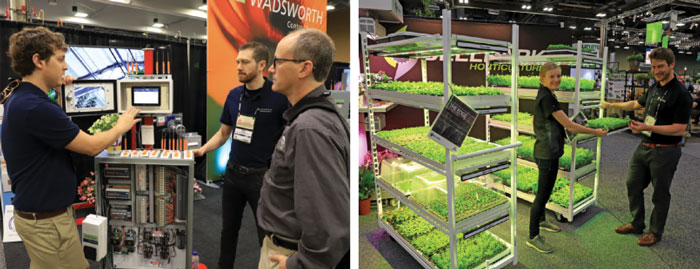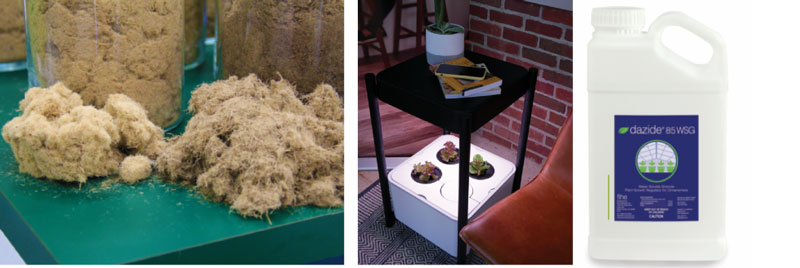9/1/2019
Treats & Trends at the Trade Show
Chris Beytes, Jennifer Polanz & Jennifer Zurko

Another Cultivate has come and gone. Our observations was that the show was packed much of Sunday and Monday, and all the major and minor players seemed to be in attendance. It was as upbeat and busy as any of the previous “Ohios” (this was Beytes’ 25th time at the show). At press time, we didn’t have final attendance numbers, but according to the exhibitors we spoke with, the right people were there and they say they were writing business.
Although we were only able to attend a handful of educational sessions between all of us, they were well-attended—certainly, there was no shortage of information on the hot topics of the day, from immigration to automation.
If you didn’t make it, all we can say is, “Why not?” All of us—whether business owner, manager or employee—benefit from regular doses of information and inspiration in order to stay engaged and relevant. Mark your calendars for Cultivate’20, which will be July 11-14.
Tech from the trade show floor

iUNU
Somebody asked if we’d seen anything featuring artificial intelligence, so it was ironic that just an hour or so later, we met the folks at iUNU (pronounced “you knew”; the I is silent). They say their greenhouse data-gathering device, called Luna, utilizes artificial intelligence to help you build a map of the location, growth rate and maturity of your crops. The company was founded by Adam Greenberg, who comes from a family orchid greenhouse background.
Luna is a precision optical device that rides on a rail over the top of your crop, taking pictures regularly (once to several times a day). That data is combined with data from stationary cameras and various environmental and light sensors, and sent to a computer, where it’s all crunched into an analysis of the real-time growth rate of your crop(s). Think of it as graphical tracking taken to a super high level and tracking every plant in the greenhouse, not just a few.
Once you have a history of growth rate and all the accompanying environment data, you can more accurately and efficiently produce your crops. You can use the technology on young plants or finished plants, and can even track plants as they flower, so you know the exact bloom percentage of a bench or bay for sales purposes. You can use the data to deploy labor and even use it to keep an eye on your crops remotely.
Pricing is via a monthly subscription model, and iUNU is very consultative in their sales and setup procedure to ensure your success with the system.
Pictured: The iUNU crew: Robert Kendrick, Jeff Kahn, Madeleine White and Shane Lewis. They didn’t have an actual Luna in the booth, but you can see a photo of it on the banner on the right.
Green Workforce's multi-purpose robot
“Robotics as a service.” That’s the tagline for Green Workforce and their interesting plant-handling robot, which they exhibited in the Blackmore Co. booth.
Originally developed to harvest strawberries, this three-axis robot has been adapted to transplant small Ellepots into larger containers or trays. But now they’re improving the technology to a more versatile six-axis system to plant more shapes and sizes, stick unrooted cuttings and trim plants. With the addition of a camera system it will be able to sort and grade, too.
Said company president Victor Cesena, “Many more tasks are on the horizon, with new tools being added every few months. We look forward to reducing labor tasks across the growing spectrum."
Interestingly, these robots are not for sale. That’s because they get paid by the piece. That’s right, Green Workforce will install your robots for free and charge you a per-plant fee based upon what you currently pay per piece for the task. If it costs you 3 cents per plug to transplant it, you’ll pay Green Workforce 3 cents per plug planted. Simple!
For a quick video of it in action, got to youtube.com/growertalks.
AIS's Big Top robot
The AgriNomix booth, once home to the HP100 “Harvey” robot, was again featuring the newest in nursery automation. “Big Top,” from Advanced Intelligence Systems (AIS) of Vancouver, British Columbia, is a motorized, rubber-tired plant-spacing robot. Like Harvey, it’s designed to pick up, move and put down pots. Unlike Harvey, which moves just one at a time, Big Top can move up to nine pots at once, up to 22 lbs. each. It’s guided by electronic cones you place at the four corners of the work area. You program it via tablet. Power comes from a pair of rechargeable batteries.
Also unlike Harvey, Big Top is modular. The base provides power, wheels and brain; the carrier and manipulation components can be changed out for various functions, such as pruning (which was on display, but not operating). They say they’ve got six more versions on the drawing board.
Similar to Green Workforce, AIS will hook you up with a Big Top on a piecework basis (plus a small licensing fee). They call it RAAS, for “robots as a service.” If it costs 8 to 12 cents for a human worker to move a plant; AIS will charge you just 5 cents for each pot moved by their robot. And, of course, being a robot, Big Top counts extremely accurately.
See for yourself at youtube.com/growertalks.

Trimmers from AgriNomix
Along with high-tech robots, AgriNomix showed some low-tech plant-trimming technology. On the fancy end of the spectrum, their automated plant trimming line has been improved: now the trimmer head spins while the plant stays still, instead of the other way around, for better stability and uniformity. On the low-tech end is the Electric EZ Cut Trimmer, a battery-powered, hand-pushed trimmer for topping plants as they sit on the ground.
Bayer’s new chemical calculators
Do you know what you’re really spending on pesticides? Bayer is hoping to make it easier for you to figure that out, while also promoting the affordability of their products. Their new “cost-in-use” calculators for two of their products—Altus insecticide and Marengo herbicide— will help you determine the overall costs of Altus or Marengo and compare them to those of any insecticide or herbicide.
You enter the product’s package size, price, use rate and other information, and the calculators will automatically list the cost per 100 gallons for insecticides and cost per month per acre for herbicides. Users can send a PDF copy of the report to their email, or download and print a copy. By comparing different products, growers can discover potential cost savings of different programs.
Both calculators are available online and are mobile friendly. You can find the one for Altus at es.bayer.us/altus-calculator and Marengo at es.bayer.us/marengo-calculator.
“We want to help growers see the value in the products they use,” said John Wendorf, Customer Marketing Manager for Lawn & Production Ornamentals for Bayer. “People think Bayer products are expensive, but they’re really not. Many times, it’s reaction to the package price; the calculators break down the big number.” (Not pictured)
The Super Max
Mitchell Ellis Products out of Semmes, Alabama, has introduced the biggest portable filler we’ve ever seen: the Super Max, which features a 10-yard soil hopper (their Max unit is a mere 4 yards). It comes with a tow package, but despite its size, it’s a standard fill-and-drill system that handles anything from flats to 15-gal. pots. It’s powered by a 15,000 watt generator (not included). Also from Mitchell Ellis is the 4 n 1 max, which features an innovative swing-away head and a foot pedal controller that allows the operator to plant bare root plants. The other three modes are filling pots, filling flats, and using as a fill-and-drill. Patent-pending, says Mitch!
Roll ’n Grow
Roll ’n Grow from BioTherm is a simple way to install rootzone heating: It features BioTherm hydronic tubes woven into a fabric mat. It comes in widths up to 12 ft. and any length you need. Just roll it out on a bench or over groundcloth, plug it in to your hot water source and start growing. And if you need a heat source, BioTherm has a new line of high-efficiency boilers with outputs of 1 to 6 million BTUs. They’re up to 99% efficient and offer the option to capture their CO2. Jim Rearden calls them “A mini boiler all grown up.”

Wadsworth’s Seed V.2
Wadsworth has updated its handy and functional little Seed environmental control with a new menu that replaces the “swipe”-style access that required you to swipe through each window to find the one you want. Now you can access all its features much more easily, and you can customize the home screen to show whichever functions are most important to you. There are lots of functional improvements inside, as well, such as being able to type in an exact temperature setting rather than having to use a slider (which you can still do, if you prefer that method). Best of all, by the end of the year they’ll have an app for phone, tablet or laptop that will function identically to the screen on the Seed itself. So you’ll be able to monitor and adjust your greenhouse settings from anyplace you’ve got cell service.
Pictured: Wadsworth’s Nick Earls and Will Justic with GrowerTalks Publisher Paul Black.
LED Trolleys
Bellpark Horticulture of Surrey, British Columbia, offers “The Edge”—a prewired LED-illuminated rack system for growing plugs, sprouts or microgreens in a small footprint. Price out the door is $2300. Pictured is Bellpark’s Kathleen Vander Ploeg and Justin van der Pullen.
New Plants

Van Belle Nursery
Some new woodie ornamentals from this Canadian producer’s popular Bloomin’ Easy collection includes a box honeysuckle called Thunderbolt that is a true, purely shade item, which would make a nice alternative for people who are kinda over hostas. The folks at Van Belle said that Thunderbolt grows so dense that it can be shaped and there are no flowers (they did say there may be some small white flowers that show up at the end of the season). So far, they’re saying it’s hardy to Zone 6, but they are trialing it in Zone 5. Thunderbolt is one of three new honeysuckles, but the other two didn’t make it to Columbus.
Also new is a spirea called Poprocks, which has even growth that’s 2.5 ft. tall to 3 ft. wide. Consumers can find care info—including the ability to sign up for free reminders—at mybloomingeasy.com.
Star’s new brand
Star Roses and Plants made their brand new brand the main focus of their booth this year. Aptly called Bloomables, it includes Star’s best flowering shrubs that are low-maintenance for the grower and consumer. Bloomables will be available at retail this spring for roses and flowering woodies, and then in 2021, some plants from Darwin Perennials’ lineup will be added. Star is calling it an “optional” program so that growers can still buy the plants in the collection, but not feel pressured to grow in the branded Bloomables pot. The program was developed in response to their customers’ demands, but they can still grow in black pots if they want to.
Riding the Wave
ForemostCo delivered a new series of Ty Dy crotons whose names play on ’80s sayings: Twisted, Gnarly, To the Max (pictured) and Tubular (they forgot Righteous, though—as in, “they think he’s a righteous dude;” maybe that’s coming soon). This series caught the eye of retailers in The Garden Center Group and they named it a Retailer’s Choice Award winner for the show. It’s no wonder it caught their eye, too, as the series features uniquely shaped and brightly colored leaf patterns.
Inputs and other hardgoods

New blends from HydraFiber
Since it was first introduced a few years ago, the wood substrate called HydraFiber has been taking the industry by storm. Many growers have trialed it and seen the benefits it provides to the root system during every stage of production, said Jennifer Neujahr, Hort Business Manager for Profile Products, the company that makes HydraFiber. But you needed a special piece of equipment to break it down because it comes in large bales.
Now, two new HydraFiber formulations are being introduced that don’t need a specific machine—the Hybrid and EZ Blend. You can use any old bale shaver or breaker for Hybrid and the EZ Blend can be broken down with a front-end loader or tractor. These substrates also feature different particle sizes so you can more easily combine them with growing media and other soil amendments like peat. And in 2020, they’ll be available as 100 cu. ft. compressed towers.
Jennifer said the goal with Hybrid and EZ Blend was to have more options and make it easier for growers of all types and sizes.
“Now everybody truly has access to our product,” she said.
Growing Indoors
During the Innovation Tour, Jen P. got a chance to get a look at some of Scotts Miracle-Gro’s new introductions this year. Along with a new line of fertilizers and compost called Performance Organics and a new smart irrigation system, the company also introduced a new indoor growing system called Twelve (because it grows all 12 months).
The system features a turnkey, water-based hydroponic system with a 60-watt equivalent LED light. Consumers can grow from seed or a finished plant transplanted into the coir liner. It’s fashionable as an end table or can be stacked for more growing options, and has an app that includes a timer to tell when to water, feed and harvest. It launched March 1 and seems to be available mostly online at a $299 retail price. Scotts also has a partnership with Bonnie Plants, and is working to test genetics that are more compact to fit into spots like this and in square-foot gardens.
Improved PGRs from Fine Americas
Dazide 85 WSG isn’t new (its active ingredient, daminozide, has been around seemingly forever), but Fine Americas has improved the packaging and formulation to make it easier to handle, use and store. For instance, it comes in a recyclable plastic jug with a screw top instead of a floppy mylar bag; it comes packed in 20-lb. cases that are sturdier, with handles, that stack better than the former 40-lb. boxes; and the formulation has been improved to work better through injectors and to allow rewetting of the product in case you didn’t apply it at the optimum time and it dried too quickly.
For garden centers

EnRoot Seed Kits
First debuted at MANTS, the novelty gift item of paper infused with wildflower seed mix makes a great addition for those looking to give gardening gifts. Distributed by EnRoot, we envision it wrapping another garden-related gift. In each package are four different 24-in. x 36-in. sheets, raffia and six cards. Retailers can order a case of 24 products, and they typically retail for anywhere between $19.99 and $24.99.
Another interesting item on display in the EnRoot booth was the Kush Kit, a grow kit for cannabis (no, the seeds aren’t included). It includes nine 32-mm sleeved disks made of buffered coir, along with a tray to start seeds, three grow cubes and three grow bags. As there are more retailers in states that have legalized recreational and/or medicinal marijuana, these types of kits may become more popular.
Andrew Pidgeon, director of Marketing for EnRoot, says the Kush Kit received “huge interest” at the show, adding the kit may have a card for discounts on seed and fertilizer, since none are included.
New Glove Designs
If you’re looking for a company with a great story that can connect with your customers, check out Womanswork, a glove designer and manufacturer. It’s a woman-owned family business for 34 years and owner Dorian Rogers Winslow does a great job of connecting with customers. She was at Cultivate highlighting a new line of arm-saver gloves designed by artist Kate Blairstone. The line will be completed in late October and will be available at the gift and trade shows in January 2020. She noted, too, that Womanswork gloves are unique because they include more padding inside the palm, where women typically have less padding than men. The gloves also feature reinforced fingertips. GT